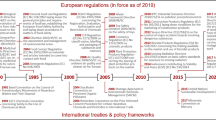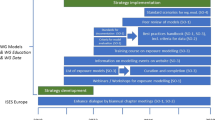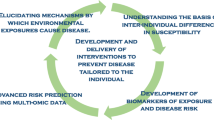Abstract
Exposure science is a holistic concept without prejudice to exposure source. Traditionally, measurements aimed at mitigating environmental exposures have not included exposures in the workplace, instead considering such exposures to be an internal affair between workers and their employers. Similarly, occupational (or industrial) hygiene has not typically accounted for environmental contributions to poor health at work. Many persons spend a significant amount of their lifetime in the workplace, where they maybe exposed to more numerous chemicals at higher levels than elsewhere in their environment. In addition, workplace chemical exposures and other exogenous stressors may increase epigenetic and germline modifications that are passed on to future generations. We provide a brief history of the development of exposure science from its roots in the assessment of workplace exposures, including an appendix where we detail current resources for education and training in exposure science offered through occupational hygiene organizations. We describe existing successful collaborations between occupational and environmental practitioners in the field of exposure science, which may serve as a model for future interactions. Finally, we provide an integrated vision for the field of exposure science, emphasizing interagency collaboration, the need for complete exposure information in epidemiological studies, and the importance of integrating occupational, environmental, and residential assessments. Our goal is to encourage communication and spur additional collaboration between the fields of occupational and environmental exposure assessment. Providing a more comprehensive approach to exposure science is critical to the study of the “exposome”, which conceptualizes the totality of exposures throughout a person’s life, not only chemical, but also from diet, stress, drugs, infection, and so on, and the individual response.
This is a preview of subscription content, access via your institution
Access options
Subscribe to this journal
Receive 6 print issues and online access
$259.00 per year
only $43.17 per issue
Buy this article
- Purchase on Springer Link
- Instant access to full article PDF
Prices may be subject to local taxes which are calculated during checkout


Similar content being viewed by others
References
Harper M . The possible toxic metal exposures of pre-historic bronze workers. Br J Ind Med 1987; 44: 652–656.
Lioy PJ . Exposure science: a view of the past and milestones for the future. Environ Health Perspect 2010; 118: 1081–1090.
Pleil JD, Blount BC, Waidyanatha S, Harper M . Establishing exposure science as a distinct scientific discipline. J Expo Sci Environ Epidemiol 2012; 22: 317–319.
Oldham PD, Roach SA . A sampling procedure for measuring industrial dust exposure. Br J Ind Med 1952; 9: 112–119.
Oldham PD . The nature of the variability of dust concentrations at the coal-face. Br J Ind Med 1953; 10: 227–234.
Roach SA . A method of relating the incidence of pneumoconiosis to airborne dust exposure. Br J Ind Med 1953; 10: 220–226.
Harper M . Occupational health aspects of the arsenic extractive industry in Great Britain (1868-1925). Br J Ind Med 1988; 45: 602–605.
Harper M, Pössel Miranda G . Management of health risks in the arsenic production industry. Ann Occup Hyg 1990; 34: 471–482.
Fraser DA . Recognition, evaluation and control: the acceleration of the process. Am Ind Hyg Assoc J 1984; 45: 573–576.
Gochfeld M . Chronological history of occupational medicine. J Occup Environ Med 2005; 47: 96–114.
Hoover MD, Armstrong T, Blodgett T, Fleeger AK, Logan PW, McArthur B et al. Leadership perspective. Confirming our IH decision-making framework. Synergist 2011; 22: 10.
National Institute for Occupational Safety and Health (NIOSH) Exposure Assessment Methods: Research Needs and Priorities. NIOSH: Cincinnati (OH). 2002 Publication No. 2002-126.
National Research Council Exposure Science in the 21st Century: A Vision and a Strategy. National Academies Press: Washington (DC). 2012, 196 pp.
Organization for Economic Cooperation and Development (OECD). OECD StatExtracts. Available at http://stats.oecd.org/Index.aspx?DatasetCode=LFS_SEXAGE_I_R. (accessed on 21 March 2014).
Benowitz NL . Cardiotoxicity in the workplace. State Art Rev Occup Med 1992; 7: 465–478.
EPA Endocrine Disruptor Research: State-of-the-Science Non-Monotonic Dose Response Curve Report - Low Dose Effects. US Environmental Protection Agency. 2013 Available at http://epa.gov/ncct/edr/non-monotonic.html. (accessed on 21 March 2014).
Genovese G, Reguira M, Da Cuña RH, Ferreira MF, Varela ML, Lo Nostro FL . Nonmonotonic response of vitellogenin and estrogen receptor α gene expression after octylphenol exposure of Cichlasoma dimerus (Perciformes, Cichlidae). Aquatic Toxicol 2014; 156: 30–40.
Liang Q, Gao X, Chen Y, Hong K, Wang H-S . Cellular mechanism of the nonmonotonic dose response of Bisphenol A in rat cardiac myocytes. Environ Health Perspect 2014; 122: 601–608.
Ball E . Birnbaum presents plenary at meeting of Canadian toxicology group.[Internet]. Environmental Factor. Available at http://www.niehs.nih.gov/news/newsletter/2014/1/spotlight-birnbaum/index.htm. (accessed on 1 April 2014).
Li C-Y, Sung F-C . A review of the healthy worker effect in occupational epidemiology. Occup Med 1999; 49: 225–229.
European Chemicals Agency Guidance on information requirements and chemical safety assessment. Chapter R.14: Occupational exposure estimation. ECHA-2010-G-09-EN Vers. 2.1. Nov, 2012. European Chemicals Agency: Helsinki, Finland. 2014 Available at http://echa.europa.eu/documents/10162/13632/information_requirements_r14_en.pdf. (accessed on 21 March 2014).
Tielemans E, Warren N, Schneider T, Tischer M, Ritchie P, Goede H et al. Tools for regulatory assessment of occupational exposure - development and challenges. J Exp Sci Environ Epidemiol 2007; 17: S72–S80.
The ETEAM-project. Available at http://www.eteam-project.eu/. (accessed on 3 December 2014).
Birnbaum LS, Bucher JR, Collman GW, Zeldin DC, Johnson AF, Schug TT et al. Consortium-based science: The NIEHS’s multipronged, collaborative approach to assessing the health effects of bisphenol A. Environ Health Perspect 2012; 120: 1640–1644.
Schug TT, Nadadur SS, Johnson AF., Nano GO . consortium - a team science approach to assess engineered nanomaterials: reliable assays and methods. Environ Health Perspect 2013; 121: A176–A177.
Rappaport SM . Implications of the exposome for exposure science. J Exp Sci Environ Epidemiol 2011; 21: 5–9.
Pleil JD, Stiegel MA . Evolution of environmental exposure science: using breath-borne biomarkers for “discovery” of the human exposome. Anal Chem 2013; 85: 9984–9990.
Brown JS, Gordon T, Price O, Asgharian B . Thoracic and respirable particle definitions for human health risk assessment. Particle Fibre Toxicol 2013; 10: 12.
Lioy PJ, Rappaport SM . Exposure science and the exposome: an opportunity for coherence in the environmental health sciences. Environ Health Perspect 2011; 119: A466–A467.
Rappaport SM, Lioy PJ . An integrated approach to the exposome: Rappaport and Lioy respond. Environ Health Perspect 2012; 120: A104.
Collins FS, Gray GM, Bucher JR . Transforming environmental health protection. Science 2008; 319: 906–907.
Schmidt CW . TOX21: new dimensions of toxicity testing. Environ Health Perspect 2009; 117: A348–A353.
MacDonald LA, Cohen A, Baron S, Burchfiel CM . Occupation as socioeconomic status or environmental exposure? A survey of practice among population-based cardiovascular studies in the United States. Am J Epidemiol 2009; 169: 1411–1421.
National Institute for Occupational Safety and Health (NIOSH). Centers for Disease Control and Prevention Report to Congress on Workers’ Home Contamination Study Conducted Under the Workers’ Family Protection Act (29 U.S.C. 671a). NIOSH: Cincinnati, OH, USA. 1995 Publication 95-123. Available at http://www.cdc.gov/niosh/pdfs/95-123.pdf. (accessed on 3 December 2014).
Hart J, Spear T, Ward T, Baldwin C, Salo M, Elashheb M . An evaluation of potential occupational exposure to asbestiform amphiboles near a former vermiculite mine. J. Environ. Public Health 2009 (10 pp.) doi: 10.1155/2009/189509.
Harper M, Butler C, Berry D, Wroble J . Where occupation and environment overlap: US Forest Service worker exposure to Libby Amphibole fibers. J Occup Environ Hyg 2015 doi:10.1080/15459624.2014.989362.
Lorber MN, Gibb H, Grant L, Pinto J, Pleil JD, Cleverly D . Assessment of inhalation exposures and potential health risks that resulted from the collapse of the World Trade Center towers. Risk Anal 2007; 27: 1203–1221.
Prezant DJ, Weiden M, Banauch GI, McGuiness G, Rom WN, Aldrich TK et al. Cough and bronchial responsiveness in firefighters at the World Trade Center site. N Engl J Med. 2002; 347: 806–815.
Pleil JD, Smith LB, Zelnick SD . Personal exposure to JP-8 jet fuel and exhaust at Air Force bases. Environ Health Perspect 2000; 108: 183–192.
Zeiger E, Smith L . The First International Conference on the Environmental Health and Safety of Jet Fuel. Environ Health Perspect 1998; 106: 763–764.
Kitt MM, Decker JA, Delaney L, Funk R, Halpin J, Tepper A et al. Protecting workers in large-scale emergency responses: NIOSH experience in the Deepwater Horizon response. J Occup Environ Med 2011; 53: 711–715.
Esswein E, Kiefer M, Snawder J, Breitenstein M . Worker exposure to crystalline silica during hydraulic fracturing. 2012 Available at http://blogs.cdc.gov/niosh-science-blog/2012/05/23/silica-fracking/. (accessed on 1 April 2014).
Howarth RW, Ingraffea A, Engelder T . Natural gas: should fracking stop? Nature 2011; 477: 271–275.
Schulte PA, Chun H . Climate change and occupational safety and health: establishing a preliminary framework. J Occup Environ Hyg 2009; 6: 542–554.
US Environmental Protection Agency. My Air, My Health: HHS/EPA Challenge. [Internet]. Available at http://epa.gov/research/challenges/. (accessed on 3 December 2014).
Mulchandani A, Myung NV, Deshusses MA, Cocker D, Wang J, Bakkaloglu B et al. Nanosensor array for real-time monitoring of diesel and gasoline exhaust exposure. Epidemiol 2008; 19: S62.
Public Health Institute Asthma and Diesel. PHI: Oakland, CA. 2014 Available at http://www.phi.org/uploads/application/files/xq1rssien18tmqtavs3k97m6ojpp6reyhgmy3ajnh9jhcjy93r.pdf. (accessed on 21 March 2014).
Peters RH, Vaught C, Hall EE, Volkwein JC . Miners’ Views About Personal Dust Monitors. National Institute for Occupational Safety and Health (NIOSH): Pittsburgh, PA, USA. 2014, 47 Information Circular 9501. DHHS (NIOSH) Publication No. 2008–110, 2008 47 pp. Available at http://www.cdc.gov/niosh/mining/UserFiles/works/pdfs/2008-110.pdf. (accessed on March 19 2014).
Leidel NA, Busch KA, Lynch JR . Occupational Exposure Sampling Strategy Manual. 2014. DHEW/NIOSH: Cincinnati, OH, USA, Publication 77-173. Available at http://www.cdc.gov/niosh/docs/77-173/pdfs/77-173.pdf. (accessed on March 18 2014).
Ignacio L, Bullock WH . A Strategy for Assessing and Managing Occupational Exposures. 3rd edn American Industrial Hygiene Association: Fairfax, VA, USA. 2006.
Hawkins NC, Norwood SK, Rock JC . A Strategy for Occupational Exposure Assessment. 1st edn American Industrial Hygiene Association Press, Akron, OH, USA. 1991.
American Industrial Hygiene Association. Exposure Assessment Strategies Committee. 2014 https://www.aiha.org/get-involved/VolunteerGroups/Pages/Exposure-Assessment-Strategies-Committee.aspx. (accessed 3 December 2014).
National Institute for Environmental Health Sciences (NIEHS). About Worker Education and Training Program. 2014 http://www.niehs.nih.gov/careers/hazmat/about_wetp/. (accessed 3 December 2014).
Alesbury RJ, Bailey SR . Addressing the needs for international training, qualifications, and career development in occupational hygiene. Ann Occup Hyg 2014; 58: 140–151.
Alesbury RJ, Bailey SR, Bianchi A, Booher L, Burgess L, Dobbie J et al. Discussion paper on industry needs for occupational hygiene. 2006 Available at http://www.ohlearning.com/community/files/Discussion%20Paper%20on%20Industry%20Needs%20for%20Occupational%20Hygiene%20Final_1.doc. (accessed on 3 December 2014).
Acknowledgements
Thanks to Dr. Cecil “Buzz” Birchfiel (NIOSH) for his input on cardiovascular mortality studies. We thank Dr. Meg Bouvier for assistance in preparing this manuscript and Dr. Leigh Cash (Los Alamos National Laboratory), Dr. Gayle DeBord (NIOSH), and Dr. John Decker (NIOSH) for review and comments.
Author information
Authors and Affiliations
Corresponding author
Ethics declarations
Competing interests
The findings and conclusions in this report are those of the author(s) and do not necessarily represent the official position of the Centers for Disease Control and Prevention/the Agency for Toxic Substances and Disease Registry. This work was reviewed by the U.S. EPA and approved for publication.
Additional information
The authors declare no conflict of interest
Appendix 1
Appendix 1
Occupationally Based Educational Resources in Exposure Science
National Institute for Occupational Safety and Health (NIOSH)
Through the Occupational Safety and Health Act of 1970, NIOSH was established separately from the Occupational Safety and Health Administration under the Department of Health, Safety, and Welfare, now Health and Human Services (HHS). NIOSH is one of the Institutes in the Centers for Disease Control and Prevention (CDC). The mission of NIOSH is to produce new scientific knowledge and provide practical solutions vital to reducing risks of injury and death in traditional industries, such as agriculture, construction, and mining. NIOSH also supports research to predict, prevent, and address emerging problems that arise from dramatic changes in the twenty-first century workplace and workforce. NIOSH partners with diverse stakeholders to study how worker injuries, illnesses, and deaths occur. NIOSH scientists design, conduct, and support targeted research, both inside and outside the institute. NIOSH and its partners support the U.S. economic strength and growth by moving research into practice through concrete and practical solutions, recommendations, and interventions for the building of a healthy, safe and capable workforce. NIOSH supports the training of occupational health and safety professionals to build capacity and meet increasing needs for a new generation of skilled practitioners, supporting academic institutions through an extramural program that includes Training Program Grants, funding for Education and Research Centers and Agricultural Centers, and grants to individual investigators. All NIOSH training courses contain an exposure assessment component, even though the word “exposure” may not be explicit in the course title. NIOSH also has extensive resources based on its publications, available through the NIOSHTIC-2 database, for example, “A Manual for Occupational Exposure Sampling Strategy”,49 which is currently under revision.
American Industrial Hygiene Association (AIHA)
Within the occupational hygiene community, exposure assessment has formed the core of managing exposures in the workplace.50 A balanced and logical approach for examining the collective exposures in the workplace environment was initially outlined with the first edition of “A Strategy for Occupational Exposure Assessment” published in 1991.51 Updated in the second edition in 2000, it was quickly followed by a progression of Professional Development Courses (PDCs) created and offered by members of the AIHA. These PDCs on occupational exposure assessment were offered as face-to-face training at national association events, and later in more current formats, such as video broadcast, webinars, and electronic file sharing. At present, AIHA offers a formal progression of coursework built on the model of exposures management as promoted in the 3rd edition, re-titled “Assessing and Managing Occupational Exposures”. Its goal is to abate harmful exposures and focuses on a ranking scheme that prioritizes limited and valuable resources, with subsequent investigation of lower-ranked (but highly uncertain) exposures. Additional courses guide the practitioner through more advanced concepts of statistical theory, use of Bayesian decision making, and tools with which to further inform and defend professional judgments. A listing of relevant PDC offerings is available from the AIHA Exposure Assessment Strategies Committee website under the heading “Exposure Assessment Strategies PDCs”.52
National Institute of Environmental Health Sciences (NIEHS)
For the past 19 years, NIEHS, in cooperation with 20 grant awardees, has designed and administered the Worker Education Training Program (WETP). This innovative program is designed to help employers meet the Occupational Safety and Health Administration (OSHA) requirements under the Hazardous Waste Operation and Emergency Response regulations (CFR 1910.120). By encouraging training for difficult-to-reach populations, the program addresses issues associated with literacy, language, and unique aspects of adult education. WETP was instrumental in training workers during the response to the World Trade Center attacks, hurricanes Katrina and Rita, the Gulf Oil Spill, and Superstorm Sandy. Details of the WETP training programs are available online.53
International Occupational Hygiene Association (IOHA)
The international occupational health community has also collaborated to share content. Thirteen member societies of the IOHA, all 11 national certification bodies, and IOHA itself are now cooperating in a new international training and qualification system. The structure broadens access to occupational hygiene education and training worldwide and complements existing professional accreditation schemes. Currently, there are 46 training providers approved in the scheme. As of the end of June 2013, almost 200 courses had been delivered in more than 32 countries, with nearly 2400 examinations taken in seven languages.54 This engagement of students, particularly in developing countries, helps address the worldwide need to combat occupational illness. It is creating the foundation for sustainable growth in the provision of occupational hygiene services worldwide. Aylesbury and Bailey were instrumental in bringing together a group of senior hygienists to review the needs of industry. The resulting position paper55, reflecting the perspective of major multinational companies, resulted from widespread consultation with a diverse group of global stakeholders. The Occupational Hygiene Training Association (OHTA), a not-for-profit organization, was created to operate the system. Complete lesson plans, student handouts, and presentation materials cover conventional topics such as occupational health and principles and application of the hierarchy of controls. They also cover specialty programs such as asbestos and fiber exposures, noise, heat stress, and ergonomics. The OH learning website provides free downloads of educational materials and details of training events (http://www.ohlearning.com/).
Rights and permissions
About this article
Cite this article
Harper, M., Weis, C., Pleil, J. et al. Commentary on the contributions and future role of occupational exposure science in a vision and strategy for the discipline of exposure science. J Expo Sci Environ Epidemiol 25, 381–387 (2015). https://doi.org/10.1038/jes.2014.91
Received:
Revised:
Accepted:
Published:
Issue Date:
DOI: https://doi.org/10.1038/jes.2014.91
Keywords
This article is cited by
-
Healthy worker, healthy citizen: the place of occupational health within public health research in Switzerland
International Journal of Public Health (2020)
-
Long-term monitoring for nanomedicine implants and drugs
Nature Nanotechnology (2016)



